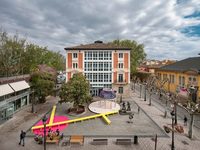Integral refurbishment of the old town of Banyoles
Banyoles
Banyoles’ old town used to be a deteriorated area in which vehicles and pedestrians cohabitated around a urban system of narrow streets and old sidewalks. The irrigation canals that originally were clean had become part of the sewer system of the city. Around the Central Square there were also sidewalks in which cars parked randomly.
The process was to pedestrianize the whole area, removing all the old sidewalks. The new intervention is made with travertine stone. This calcareous stone has always been present in the city’s subsoil. All the enigmatic buildings, churches, medieval houses or monuments were also raised with travertine.
The departing point is to cover the Central Square (the most relevant part of the project) using a tessellation of travertine. The proliferation of this tiling arrives to the streets and minor squares in different phases of the project. On the other hand, the irrigation system is uncovered intermittently across the pedestrian ways. Eventually, it is opened in bigger sections so children can play as if they were in front of a puddle of water.
Re-paving the city centre defines a new pedestrian area. It corresponds to a part of Banyoles in which the traces of the medieval age are still present. In fact, the urban planning at the historical centre shows up as a sequence of squares as Plaça dels Turers. Plaça Major (Central Square), Plaça dels estudis (Studies Square), Plaça de la Font (Fountain Square), Plaça del teatre (Theater Square), Plaça de l’Església Santa Maria (Square of the church of Santa Maria), Plaça del Monestir (Monastery Square). Most of these names are given due to the buildings to which the squares give access (mainly churches and museums).
The second part of the intervention was to recover the irrigation canals. Originally, these waterways came from Banyoles’ Lake, crossed the city and supplied water to the backyards of the houses. The disappearance of these private gardens generated the progressive covering and degeneration of the quality of the canalized water.
The project restores circulation of people and water through the old town of Banyoles, giving them back the itineraries they occupied originally.
We chose the same material in which all the city centre is built. The tiles of travertine stone generate folds in order to form canals or regulation gates. We break the linearity of the pedestrian paths making cuts in their surface so the flow of water can be felt. Certainly, the purpose is to exhaust the possibilities of the material of travertine itself, from the soil to the new paving passing through water.
We strongly believe that the old town will now become a sequence of paths in which the inhabitants would have the possibility to enjoy the historical centre and its 12th Century architecture. From now on, the pedestrian will always be accompanied by the presence of water...
- Arquitectos
- MIAS Architects
- Ano
- 2012
Projetos relacionados
Revista
-
-
-
-
Un despatx madrileny signa un visionari catalitzador urbà en West Palm Beach
Andrea Pala | 29.11.2018 -
L'arquitectura de Francis Keré en escena en el Museu ICO de Madrid
Andrea Pala | 28.10.2018














